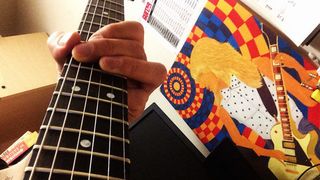Jazz Guitar Corner: Learn to Play Three Classic Jazz Blues Licks
You'll have plenty of musical ammo for your jazz-blues solos once you pick up these licks.

Anyone learning how to play jazz guitar will know that the blues makes up a large part of the jazz soloing, comping and writing traditions.
From the licks famous jazzers play, to the chord progressions they write their tunes over, the blues is deeply integrated into jazz soloing and composition.
Because the jazz blues chord progression and soloing approach is such a big part of the jazz vocabulary, learning how to play a 12-bar jazz blues form and solo using jazz blues licks is an essential tool in the vocabulary of any developing jazz guitarist.
In today’s lesson, we’ll be digging into three classic Jazz Blues licks that you can learn, take into your own solos and expand upon to make them your own as you continue your study of the Jazz Blues sound in the practice room. If you are new to jazz blues, check out my article “How to Play a Jazz Blues Chord Progression” for more info on the jazz approach to the 12-bar blues form.
Classic Jazz Blues Lick 1
This first jazz blues lick is reminiscent of Blue Note-era saxophonists such as Hank Mobley, Stanley Turrentine and even Sonny Rollins’ work from the late ’50s and early ‘60s. Though it’s a short and relatively easy lick to get under your fingers, it can go a long way in bringing the jazz blues sound to your licks and solos.
Tips for Practicing This Lick
•Nailing the triplet rhythm in bar one, then leading smoothly into the slide on the downbeat of the second bar
•Adding a bit of vibrato to the long Bb, 3rd fret 3rd string, that makes up most of the duration of the second bar
•Using a bend, slide or hammer-on between the Ab and A on the fourth beat of bar 2, this gives it that mix of major and minor blues sounds as the Ab comes from the minor blues scale and the A comes from the major blues and arpeggio of the underlying F7 chord
Check this lick out in the woodshed. It’s a great, minor meets major blues scale run that really digs deep on the time feel when you bring it to a jam or gig situation.

Classic Jazz Blues Lick 2
This lick is taken right from the Pat Martino School of jazz blues soloing. Though the notes themselves are easy to play, the lick is basically made up of the b3, 3 and 5th of the chord repeated over and over, the rhythmic syncopation that occurs when you play those three notes against the 16th note pulse creates a huge amount of intensity in your lines as you bring it to a combo situation.
Tips for Practicing This Lick
•Accent the G# each time it comes around to really bring out the syncopated 3-note pattern over the 4 16th-notes that make up each beat in the bar
•Try both hammer-ons and slides between the G# and the A to add different textures to the slurred part of the line
•Work with a metronome, starting slow, and focus on being as clear and accurate with the 16th notes as you can
This lick is not only bluesy, mixing the minor and major 3rd intervals over the F7 chord, but the 3 over 4 feel that it brings to the table can really lift the energy level and intensity of your solos in a Martino-style manner.

Classic Jazz Blues Lick 3
This last lick is an easy to play line that brings to mind the melody of Dizzy Gillespie’s tune “Birks Works.” Built using only the notes of the F minor blues scale, this lick is more about laying back on the time feel and digging deep into the pocket than it use using complex notes to gain its effect.
Tips for Practicing This Lick
•Lay back on the time and don’t rush the rhythm in order to get that smooth, swing feel that makes this lick work so well
•Be very accurate with the 16th note triplets in bar two, avoid playing them “fast” vs. the “slow” 8th notes, make sure they are given the exact rhythmic duration that’s written
•Experiment with adding in slides, hammer-ons and pull-offs to different notes in this lick to give it that “slippery” sound that makes the jazz blues so much fun to listen to
Though it’s basically just a minor blues scale played up and down, this lick and its variations have been a stable of the jazz blues diet for decades, and this simple idea can really bring a deep sense of the blues side of jazz to your solos.

The blues and blues licks are an important part of the vocabulary of any jazz guitarist. By learning classic licks such as these, you can ensure that you have plenty of musical ammo for your solos the next time somebody calls a jazz blues tune on the bandstand or in the jam room.
What do you think of these licks? Share your thoughts in the comments section below.
Matt Warnock is the owner of mattwarnockguitar.com, a free website that provides hundreds of lessons and resources designed to help guitarists of all experience levels meet their practice and performance goals. Matt lives in the UK, where he is a senior lecturer at the Leeds College of Music and an examiner for the London College of Music (Registry of Guitar Tutors).
Get The Pick Newsletter
All the latest guitar news, interviews, lessons, reviews, deals and more, direct to your inbox!
Matt Warnock is the owner of mattwarnockguitar.com, a free website that provides hundreds of lessons and resources designed to help guitarists of all experience levels meet their practice and performance goals. Matt lives in the UK, where he teaches Skype guitar students all over the world, and is an examiner for the London College of Music (Registry of Guitar Tutors).

Want to play Master of Puppets the right way? Here's how to get faster at downpicking so you can chug like James Hetfield

“A few poorly intonated sustained bends in a solo can make the guitar's most emotive technique sound bad”: Learning how to bend strings correctly is one of the quickest ways to make your playing sound better


![Joe Bonamassa [left] wears a deep blue suit and polka-dotted shirt and plays his green refin Strat; the late Irish blues legend Rory Gallagher [right] screams and inflicts some punishment on his heavily worn number one Stratocaster.](https://cdn.mos.cms.futurecdn.net/cw28h7UBcTVfTLs7p7eiLe-840-80.jpg)






